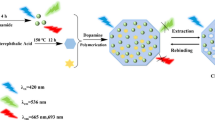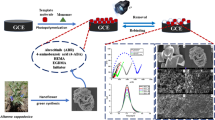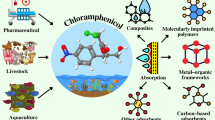Abstract
Molecularly imprinted polymers were synthesized by gel–sol method with multi-walled carbon nanotubes as support and enrofloxacin as a template and further modified on the surface of glassy carbon electrode to construct a molecularly imprinted electrochemical sensor. The performance of the imprinted electrochemical sensor was thoroughly investigated by using cyclic voltammetry and differential pulse voltammetry. The influence of imprinted polymers amount, electrolyte pH, and incubation time on the sensor performance was investigated for the detection of enrofloxacin. Under the optimal experimental conditions in a three-electrode system with the modified electrode as the working electrode the differential pulse voltammetry response current of the sensor had a good linear relationship at 0.2 V (vs. saturated calomel reference electrode) with the enrofloxacin concentration within 2.8 pM–28 μM and the limit of detection of the method was 0.9 pM. The competitive interference experiment showed that the imprinted electrochemical sensor could selectively recognize enrofloxacin. The method was applied to analyze spiked natural seawater, fish, and shrimp samples. The recovery was 96.4%–102%, and RSD was less than 4.3% (n = 3), indicating that the proposed imprinted electrochemical sensor was suitable for the determination of trace enrofloxacin in marine environment samples.
Graphical abstract







Similar content being viewed by others
References
Rosa J, Leston S, Crespo D, Freitas A, Vila Pouca AS, Barbosa J, Lemos MFL, Pardal MÂ, Ramos F (2020) Uptake of enrofloxacin from seawater to the macroalgae Ulva and its use in IMTA systems. Aquaculture 516:734609. https://doi.org/10.1016/j.aquaculture.2019.734609
Zhou XJ, Chen CX, Yue L, Sun YX, Ding HZ, Liu YH (2008) Excretion of enrofloxacin in pigs and its effect on ecological environment. Environ Toxicol Phar 26:272–277. https://doi.org/10.1016/j.etap.2008.04.004
Slana M, Zigon D, Sollner-Dolenc M (2017) Enrofloxacin degradation in broiler chicken manure under field conditions and its residuals effects to the environment. Environ Sci Pollut R 24:13722–13731. https://doi.org/10.1007/s11356-017-8722-1
Zhang Y, Wang L, Zhuang H, Li X, Gao X, An Z, Liu X, Yang H, Wei W, Zhang X (2019) Excessive use of enrofloxacin leads to growth inhibition of juvenile giant freshwater prawn Macrobrachium rosenbergii. Ecotox Environ Safe 169:344–352. https://doi.org/10.1016/j.ecoenv.2018.11.042
Xiao Y, Lyu H, Tang J, Wang K, Sun H (2020) Effects of ball milling on the photochemistry of biochar: enrofloxacin degradation and possible mechanisms. Chem Eng J 384:123311. https://doi.org/10.1016/j.cej.2019.123311
Tang YW, Li M, Gao X, Liu XY, Ma Y, Li Y, Xu YX, Li JR (2016) Preconcentration of the antibiotic enrofloxacin using a hollow molecularly imprinted polymer, and its quantitation by HPLC. Microchim Acta 183:589–596. https://doi.org/10.1007/s00604-015-1681-7
Xiong JQ, Kurade MB, Jeon BH (2017) Ecotoxicological effects of enrofloxacin and its removal by monoculture of microalgal species and their consortium. Environ Pollut 226:486–493. https://doi.org/10.1016/j.envpol.2017.04.044
Álvarez-Esmorís C, Conde-Cid M, Ferreira-Coelho G, Fernández-Sanjurjo MJ, Núñez-Delgado A, Álvarez-Rodríguez E, Arias-Estévez M (2020) Adsorption/desorption of sulfamethoxypyridazine and enrofloxacin in agricultural soils. Sci Total Environ 706:136015. https://doi.org/10.1016/j.scitotenv.2019.136015
Huang J, Li D, Li R, Chen P, Zhang Q, Liu H, Lv W, Liu G, Feng Y (2020) One-step synthesis of phosphorus/oxygen co-doped g-C3N4/anatase TiO2 Z-scheme photocatalyst for significantly enhanced visible-light photocatalysis degradation of enrofloxacin. J Hazard Mater 386:121634. https://doi.org/10.1016/j.jhazmat.2019.121634
Pei Y, Zeng L, Wen C, Wu K, Deng A, Li J (2021) Detection of enrofloxacin by flow injection chemiluminescence immunoassay based on cobalt hydroxide nanozyme. Microchim Acta 188:194. https://doi.org/10.1007/s00604-021-04846-6
Sciscenko I, Garcia-Ballesteros S, Sabater C, Castillo MA, Escudero-Oñate C, Oller I, Arques A (2020) Monitoring photolysis and (solar photo)-Fenton of enrofloxacin by a methodology involving EEM-PARAFAC and bioassays: role of pH and water matrix. Sci Total Environ 719:137331. https://doi.org/10.1016/j.scitotenv.2020.137331
Hu S, Fang BL, Huang Z, Chen Y, Liu DF, Xing KY, Peng J, Lai WH (2019) Using molecular descriptors for assisted screening of heterologous competitive antigens to improve the sensitivity of ELISA for detection of enrofloxacin in raw milk. J Dairy Sci 102:6037–6046. https://doi.org/10.3168/jds.2018-16048
Terrado-Campos D, Tayeb-Cherif K, Peris-Vicente J, Carda-Broch S, Esteve-Romero J (2017) Determination of oxolinic acid, danofloxacin, ciprofloxacin, and enrofloxacin in porcine and bovine meat by micellar liquid chromatography with fluorescence detection. Food Chem 221:1277–1284. https://doi.org/10.1016/j.foodchem.2016.11.029
Ye YL, Ji J, Sun ZY, Shen PL, Sun XL (2020) Recent advances in electrochemical biosensors for antioxidant analysis in foodstuff. TrAC- Trend Anal Chem 122:115718. https://doi.org/10.1016/j.trac.2019.115718
Arduini F, Cinti S, Scognamiglio V, Moscone D, Palleschi G (2017) How cutting-edge technologies impact the design of electrochemical (bio)sensors for environmental analysis. A review, Anal Chim Acta 959:15–42. https://doi.org/10.1016/j.aca.2016.12.035
Akhoundian M, Alizadeh T, Ganjali MR, Norouzi P (2019) Ultra-trace detection of methamphetamine in biological samples using FFT-square wave voltammetry and nano-sized imprinted polymer/MWCNTs-modified electrode. Talanta 20:115–123. https://doi.org/10.1016/j.talanta.2019.02.027
Wang YY, Han M, Ye XX, Wu KB, Wu T, Li CY (2016) Voltammetric myoglobin sensor based on a glassy carbon electrode modified with a composite film consisting of carbon nanotubes and a molecularly imprinted polymerized ionic liquid. Microchim Acta 184:1–8. https://doi.org/10.1007/s00604-016-2005-2
Diouf A, El Bari N, Bouchikhi B (2020) A novel electrochemical sensor based on ion imprinted polymer and gold nanomaterials for nitrite ion analysis in exhaled breath condensate. Talanta 209:120577. https://doi.org/10.1016/j.talanta.2019.120577
Sipa K, Brycht M, Borgul P, Poltorak L (2020) Electrochemical sensing of fluoroquinolone antibiotics. TrAC-Trend Anal Chem 128:115907. https://doi.org/10.1016/j.trac.2020.115907
Rudnicki K, Poltorak L, Skrzypek S, Skrzypek S (2019) Ion transfer voltammetry for analytical screening of fluoroquinolone antibiotics at the water – 1.2-dichloroethane interface. Anal Chim Acta 1085:75–84. https://doi.org/10.1016/j.aca.2019.07.065
Aymard C, Kanso H, Serrano MJ, Pagan R, Noguer T, Istamboulie G (2022) Development of a new dual electrochemical immunosensor for a rapid and sensitive detection of enrofloxacin in meat samples. Food Chem 370:131016. https://doi.org/10.1016/j.foodchem.2021.131016
Goncalves DA, Carmo JS, Zanon LTS, Marangoni BS, Cena C, Camara GA, Donati GL, Trindade MAG (2022) Simultaneous quantification of seven multi-class organic molecules by single-shot dilution differential pulse voltammetric calibration. Talanta 237:122975. https://doi.org/10.1016/j.talanta.2021.122975
Li X, Chen J, He X, Wang Z, Wu D, Zheng X, Zheng L, Wang B (2019) Simultaneous determination of neonicotinoids and fipronil and its metabolites in environmental water from coastal bay using disk-based solid-phase extraction and high-performance liquid chromatography–tandem mass spectrometry. Chemosphere 234:224–231. https://doi.org/10.1016/j.chemosphere.2019.05.243
He XP, Mei XQ, Wang JT, Lian ZR, Tan LJ, Wu W (2016) Determination of diethylstilbestrol in seawater by molecularly imprinted solid-phase extraction coupled with high-performance liquid chromatography. Mar Pollut Bull 102:142–147. https://doi.org/10.1016/j.marpolbul.2015.11.041
Martins RO, Gomes IC, Mendonça Telles AD, Kato L, Souza PS, Chaves AR (2020) Molecularly imprinted polymer as solid phase extraction phase for condensed tannin determination from Brazilian natural sources. J Chromatogra A 1620:460977. https://doi.org/10.1016/j.chroma.2020.460977
Chen JL, Wang JT, Tan LJ (2019) Highly selective separation and detection of cyromazine from seawater using graphene oxide based molecularly imprinted solid-phase extraction. J Sep Sci 42:2100–2106. https://doi.org/10.1002/jssc.201900232
Huang Z, He J, Li H, Zhang M, Wang H, Zhang Y, Li Y, You L, Zhang S (2020) Synthesis and application of magnetic-surfaced pseudo molecularly imprinted polymers for zearalenone pretreatment in cereal samples. Food Chem 308:125696. https://doi.org/10.1016/j.foodchem.2019.125696
Zhou T, Ding L, Che G, Jiang W, Sang L (2019) Recent advances and trends of molecularly imprinted polymers for specific recognition in aqueous matrix: preparation and application in sample pretreatment. TrAC-Trend Anal Chem 114:11–28. https://doi.org/10.1016/j.trac.2019.02.028
Anantha-Iyengar G, Shanmugasundaram K, Nallal M, Lee KP, Whitcombe MJ, Lakshmi D, Sai-Anand G (2019) Functionalized conjugated polymers for sensing and molecular imprinting applications. Prog Polym Sci 88:1–129. https://doi.org/10.1016/j.progpolymsci.2018.08.001
Sun S, Chen L, Shi H, Li Y, He X (2014) Magnetic glass carbon electrode, modified with magnetic ferriferrous oxide nanoparticles coated with molecularly imprinted polymer films for electrochemical determination of bovine hemoglobin. J Electroanal Chem 734:18–24. https://doi.org/10.1016/j.jelechem.2014.09.034
Anirudhan TS, Deepa JR, Stanly N (2019) Fabrication of a molecularly imprinted silylated graphene oxide polymer for sensing and quantification of creatinine in blood and urine samples. Appl Surf Sci 466:28–39. https://doi.org/10.1016/j.apsusc.2018.10.001
Zuo P, Gao J, Peng J, Liu J, Zhao M, Zhao J, Zuo P, He H (2016) A sol-gel based molecular imprint incorporating carbon dots for fluorometric determination of nicotinic acid. Microchim Acta 183:329–336. https://doi.org/10.1007/s00604-015-1630-5
Arabi M, Ostovan A, Bagheri AR, Guo X, Li J, Ma J, Chen L (2020) Hydrophilic molecularly imprinted nanospheres for the extraction of rhodamine B followed by HPLC analysis: a green approach and hazardous waste elimination. Talanta 215:120933. https://doi.org/10.1016/j.talanta.2020.120933
Liao S, Zhang W, Long W, Hou D, Yang X, Tan N (2016) Adsorption characteristics, recognition properties, and preliminary application of nordihydroguaiaretic acid molecularly imprinted polymers prepared by sol–gel surface imprinting technology. Appl Surf Sci 364:579–588. https://doi.org/10.1016/j.apsusc.2015.12.184
Rezaei B, Boroujeni MK, Ensafi AA (2014) A novel electrochemical nanocomposite imprinted sensor for the determination of lorazepam based on modified polypyrrole@sol-gel@gold nanoparticles/pencil graphite electrode. Electrochim Acta 123:332–339. https://doi.org/10.1016/j.electacta.2014.01.056
Yücebaş BB, YamanYT BG, Özgür E, Uzun L, Abaci S (2020) Molecular imprinted polymer based electrochemical sensor for selective detection of paraben. Sensor Actuat B-Chem 305:127368. https://doi.org/10.1016/j.snb.2019.127368
Xu Z, Jiang X, Liu S, Yang M (2020) Sensitive and selective molecularly imprinted electrochemical sensor based on multi-walled carbon nanotubes for doxycycline hyclate determination. Chinese Chem Lett 31:185–188. https://doi.org/10.1016/j.cclet.2019.04.026
Jerome R, Sundramoorthy AK (2020) Preparation of hexagonal boron nitride doped graphene film modified sensor for selective electrochemical detection of nicotine in tobacco sample. Anal Chim Acta 1132:110–120. https://doi.org/10.1016/j.aca.2020.07.060
Mathieu-Scheers E, Bouden S, Grillot C, Nicolle J, Warmont F, Bertagna V, Cagnon B, Vautrin-Ul C (2019) Trace anthracene electrochemical detection based on electropolymerized-molecularly imprinted polypyrrole modified glassy carbon electrode. J Electroanal Chem 848:113253. https://doi.org/10.1016/j.jelechem.2019.113253
Liu XY, Ren J, Su LH, Gao X, Tang YW, Ma T, Zhu LJ, Li JR (2017) Novel hybrid probe based on double recognition of aptamer-molecularly imprinted polymer grafted on upconversion nanoparticles for enrofloxacin sensing. Biosens Bioelectron 87:203–208. https://doi.org/10.1016/j.bios.2016.08.051
Zhang ZZ, Liu Q, Zhang M, You FH, Hao N, Ding CF, Wang K (2021) Simultaneous detection of enrofloxacin and ciprofloxacin in milk using a bias potentials controlling-based photoelectrochemical aptasensor. J Hazard Mater 416:125988. https://doi.org/10.1016/j.jhazmat.2021.125988
Dong X, Li ZX, Sun XJ, Xing LH, Peng JX, Song CH (2017) Simultaneous determination of seventeen quinolones in aquaculture seawater using solid-phase extraction and liquid chromatography tandem mass spectrometry. Progress In Fishery Sciences 38:127–138. https://doi.org/10.11758/yykxjz.20160905001
Funding
This work was supported by the National Key R&D Program of China [grant number 2019YFC140027-02, 2016YFC1402101], the National Natural Science Foundation of China [grant number 41876078], and The Postdoctoral Innovative Talents Support Program of Shandong Province [grant number SDBX2020015].
Author information
Authors and Affiliations
Corresponding authors
Ethics declarations
Conflict of interest
The authors declare no competing interests.
Additional information
Publisher's note
Springer Nature remains neutral with regard to jurisdictional claims in published maps and institutional affiliations.
Supplementary Information
Below is the link to the electronic supplementary material.
Rights and permissions
About this article
Cite this article
Chen, J., Tan, L., Qu, K. et al. Novel electrochemical sensor modified with molecularly imprinted polymers for determination of enrofloxacin in marine environment. Microchim Acta 189, 95 (2022). https://doi.org/10.1007/s00604-022-05205-9
Received:
Accepted:
Published:
DOI: https://doi.org/10.1007/s00604-022-05205-9




